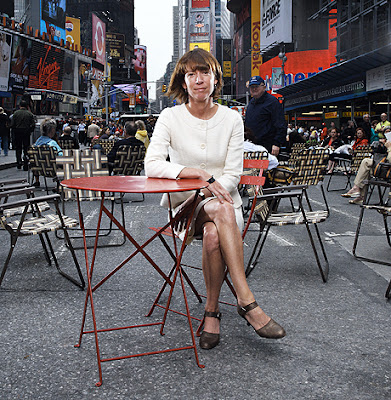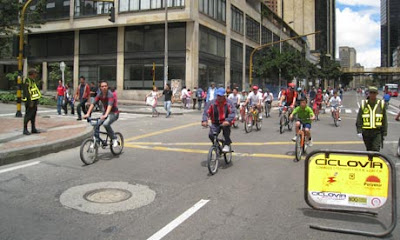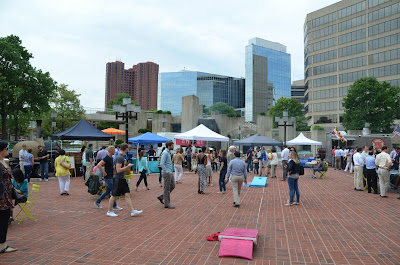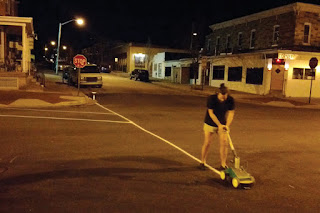For Tactical Urbanism on City Streets
It was about 1977 when folks from the Department of Public Works of my Stuttgart Borough of Bad Cannstatt engaged in some tactical urbanism by nailing railroad ties to the pavement of some streets in my neighborhood. In just a few hours they had some streets converted in segments of opposing one way streets to curtail cut-through traffic, had created pinch-points to slow traffic and installed the first ever counter-flow bike lane in all of the State. Baffled residents and drivers who hadn't followed the months of public debate in the local council were consoled by the assurance that this was only a test. Should it not work out, those tiles would be removed after at the latest three months, or earlier, should something appear to be dangerous.
Their experiments, though, never did lead to any out-of-the-ordinary traffic safety occurrence, and in fact, residents loved the newly more peaceful feel of the streets. Some eight years later, almost all chicanes and ties had been turned into permanent solutions with stone curbs, planters and finally traffic signs.
In 2009 New York's iconic Traffic Commissioner Janette Zadik Khan got out paint brushes and folding chairs and converted a section of Broadway at Times Square into a pedestrian precinct. In 2013 the matter was made permanent with some design help from Snohetta Architects.
In a time when neither Congress nor the local city council seem to be able to get anything of significance passed (witness how long it took Congress to pass a long-term transportation bill or how long it has already taken in Baltimore to deliberate the new zoning code), tactical urbanism of the sort described above looks incredibly attractive. Low cost, fast, adjustable and even fully reversible, what is not to like?
 |
| Zadik Khan enjoying a reclaimed street space in Manhattan |
The lack of resources is no longer an excuse not to act. The idea that action should only be taken after all the answers and the resources have been found is a sure recipe for paralysis. The planning of a city is a process that allows for corrections; it is supremely arrogant to believe that planning can be done only after every possible variable has been controlled. (Jamie Lerner, architect and former mayor of Curitiba, Brasil).
Instead of spending hundreds of thousands of dollars on traffic studies that remain ultimately inconclusive (witness Baltimore's study if a pair of one way streets in historic Mount Vernon should be turned into two-way streets), go ahead, try it out and collect real world data. Even though traffic engineers model significant additional delays and stressed-out rush hour commuters think that the sky will fall, it really won't, just like it didn't even when a real catastrophe struck and an Earthquake brought down portions of the elevated Embarcadero in San Francisco. Once the freeway was gone, the traffic largely disappeared and the city never looked back. (The magic trick consists of the reversal of induced demand, where more supplies begets more demand).
A more ad-hoc approach is especially desirable in a time when most conventional traffic engineering and science appears to become obsolete faster than we can grasp what is going on. We are at the cusp of complete paradigm shift in transportation that comes in equal parts from a new attitude towards the car and from disruptive technologies such as autonomous vehicles. While experts still debate if the AVs are even possible, semi-AVs already populate the showrooms: Cars that stay in lanes, accelerate, and break on their own combined with real time software that proposes better routes than even experienced cab drivers can think of as quickly. Some experts predict that about 50% of the urban space currently devoted to cars could become available for higher and better uses than storing empty cars (typically called parking). That's a lot of space, it is high time that urban planners begin to design it. To date we have mostly fancy terms such as "complete streets", "bike boulevards" and the like. Good intentions, sure, but design is often an afterthought. As a result many streets look like a real mess once all the new contraptions are included, not to mention a big snowstorm which turns many an installation into nothing more than a plow obstacle. Tactical urbanism, experimental installations, and pilots are the right answer. A yearlong practice test through all seasons can show what works and what does not.
Baltimore City has a "complete streets" policy in place but there are hardly any complete streets to be seen in the city, except those that were born that way. First there was no money, then there was no staff to design or write requests for proposals, and eventually the city had bigger fish to fry than pedestrian enhancements and streets space reclamation. Yet, aside from the one way issue there is at least one other important example in Baltimore where things can't progress because "the traffic study is not yet complete": Connecting McKeldin Plaza, Baltimore's "Occupy" park, to the Inner Harbor would bring about significant changes to traffic flow. So engineers have been studying the matter for some time without sharing the results.
The benefits of that particular connection which would require the closure of a four lane downtown exit ramp would be so spectacular that it seems entirely wrong to ask traffic engineers for permission. Instead, the Planning Department should say "we want that set of lanes closed, find us a solution that makes this work with the smallest amount of negative impacts." Tactical urbanism in large part is a reversal of priorities in which residents, planners and urban designers wrestle control of the public space from traffic engineers and regain control over how the city really looks. Considering that about 30% of a city's footprint is devoted to streets, the significance of that realm can hardly be overstated.
All around the world there are examples how people can take back the space they had until the automobile took over, even if this isn't always called tactical urbanism. Especially fast growing large cities in South America like Curitiba, Medellin and Bogota had become hopelessly clogged up and unhealthy without the cash to build elaborate subway systems provide good examples of an almost ad-hoc reversal of policies. Courageous mayors took back the streets and gave them to the people for at least one day a week in what has become globally known as ciclovia. (Baltimore and many other US cities adopted a monthly tamer version known as bike party). In fact, Baltimore has a great history of closing even an expressway going 18 years back, the once a year closure one half of its "JFX" expressway into downtown to cars opening it up for walkers and bicyclists.) The benefit of those events? A change of perception. Tactical urbanism relies heavily on disrupting our usual expectations and view patterns. At times it is the sensation of re-occupying public space, re-experiencing and re-seeing it with the (slower) eyes of the pedestrian what matters more than the actual closure (short as it may be).
Instead of spending hundreds of thousands of dollars on traffic studies that remain ultimately inconclusive (witness Baltimore's study if a pair of one way streets in historic Mount Vernon should be turned into two-way streets), go ahead, try it out and collect real world data. Even though stressed-out rush hour commuters may warn that the sky will fall, it really won't, just like it didn't even when a real catastrophe struck and an Earthquake brought down portions of the elevated Embarcadero in San Francisco. Once the freeway was gone, the traffic largely disappeared and the city never looked back. (A magic trick that relies on a reverse of the logic of induced demand)
A more ad-hoc approach is especially desirable in a time when most conventional traffic engineering and science appears to become obsolete faster than we can grasp what is going on. We are at the cusp of complete paradigm shift in transportation that comes in equal parts from a new attitude towards the car and from disruptive technologies such as autonomous vehicles. While experts still debate if the AVs are even possible, semi-AVs already populate the showrooms: Cars that stay in lanes, accelerate, and break on their own combined with real time software that proposes better routes than even experienced cab drivers can think of as quickly. Some experts predict that about 50% of the urban space currently devoted to cars could become available for higher and better uses than storing empty cars (typically called parking). That's a lot of space, it is high time that urban planners begin to design it. To date we have mostly fancy terms such as "complete streets", "bike boulevards" and the like. Good intentions, sure, but design is often an afterthought. As a result many streets look like a real mess once all the new contraptions are included, not to mention a big snowstorm which turns many an installation into nothing more than a plow obstacle. Tactical urbanism, experimental installations, and pilots are the right answer. A yearlong practice test through all seasons can show what works and what does not.
Baltimore City has a "complete streets" policy in place but there are hardly any complete streets to be seen in the city, except those that were born that way. First there was no money, then there was no staff to design or write requests for proposals, and eventually the city had bigger fish to fry than pedestrian enhancements and streets space reclamation. Yet, aside from the one way issue there is at least one other important example in Baltimore where things can't progress because "the traffic study is not yet complete": Connecting McKeldin Plaza, Baltimore's "Occupy" park, to the Inner Harbor would bring about significant changes to traffic flow. So engineers have been studying the matter for some time without sharing the results.
The benefits of that particular connection which would require the closure of a four lane downtown exit ramp would be so spectacular that it seems entirely wrong to ask traffic engineers for permission. Instead, the Planning Department should say "we want that set of lanes closed, find us a solution that makes this work with the smallest amount of negative impacts."
The call for better design and for tactical urbanism appear to be in conflict. Railroad ties and instant traffic islands, "bulb-outs", and bollards are hardly pretty to look at and seem to represent the type of clutter that was described above as not only unappealing but also non-functional for street-cleaning or snow plowing. True, but the idea is, of course that those provisional solutions would not become permanent. Just like wood models used to precede metal in car design, the ad-hoc measures are only steps towards a better, more robust, year round practical street that serves everybody. As Jamie Lerner pointed out in his statement about direct action, simulations and models cannot always tell us exactly what will happen in a real city where complexity and unpredictability is one of the characteristics we cherish as "urban". A city street, especially a "complete" one cannot be perfectly modeled, even with the best software, and especially not if we add variables such as autonomous vehicles, electric bicycles, bike share, car share stations and Uber.
Let's allow more experiments in our cities, so we can catch up with the disruptions we will inevitably face!
The call for better design and for tactical urbanism appear to be in conflict. Railroad ties and instant traffic islands, "bulb-outs", and bollards are hardly pretty to look at and seem to represent the type of clutter that was described above as not only unappealing but also non-functional for street-cleaning or snow plowing. True, but the idea is, of course that those provisional solutions would not become permanent. Just like wood models used to precede metal in car design, the ad-hoc measures are only steps towards a better, more robust, year round practical street that serves everybody. As Jamie Lerner pointed out in his statement about direct action, simulations and models cannot always tell us exactly what will happen in a real city where complexity and unpredictability is one of the characteristics we cherish as "urban". A city street, especially a "complete" one cannot be perfectly modeled, even with the best software, and especially not if we add variables such as autonomous vehicles, electric bicycles, bike share, car share stations and Uber.
Let's allow more experiments in our cities, so we can catch up with the disruptions we will inevitably face! Along the way we may learn to see our public places with different eyes and become sensitized to the beauty lingering underneath the skin which has become gruff under the onslaught of traffic.
Klaus Philipsen, FAIA
Links:
Fighting traffic one paintbrush at a time
The official guide to tactical urbanism (CityLab), PDF
What 'Tactical Urbanism' Can (and Can't) Do for Your City (CityLab)
Tactical Urbanism, SHORT-TERM ACTION FOR LONG-TERM CHANGE








